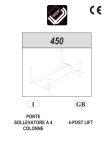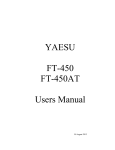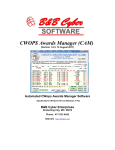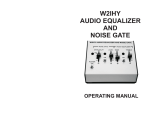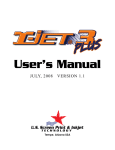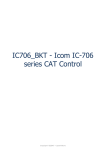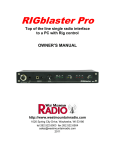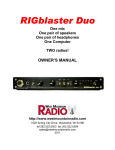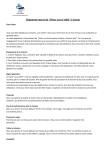Download Icom IC-7000 Frequently Asked Questions (FAQ)
Transcript
Icom IC-7000 Frequently Asked Questions (FAQ)
Icom IC-7000 Frequently Asked Questions (FAQ)
This guide was created to answer the most commonly asked questions about the Icom IC-7000. The
goal is two-fold:
1) Condense the discussions found in the Yahoo group to the raw information providing a definitive
source for the FAQ reader
2) Remove these recurring questions from the group to improve the “signal to noise ratio”
Instructions for updating, correcting and adding information are located at the end of this FAQ.
IC-7000 Unique Features
•
The IC-7000 was the smallest multimode radio available at its introduction (and the time of this
writing)
•
It was the first truly mobile radio to feature IF-DSP (customizable filters – nothing to buy)
•
Filter width adjustable by mode with “sharp” and “soft” shape factors
•
Dual ADI Blackfin DSP Processors - feature set similar to the IC-7800, IC-756 Pro III
•
ACG loop performance controlled by DSP
•
Auto notch plus dual manual notch filters for up to 70 dB of attenuation
•
Noise blanker features adjustable pulse width and depth of cut
•
Internal RTTY decode and dual peak RTTY filter
•
High stability crystal oscillator is standard
•
Voice synthesizer standard
•
VFO knob includes a working “spinner”
•
The VFO knob tension is adjustable from free to tight and detented – great for mobile operation!
•
Microphone and external speaker jacks on both the head and body
•
Color composite video output available at all times to support a larger monitor
•
Multifunction display shows complete receiver status, S-meter/power output, ALC,
compression, SWR and final temperature on a single screen
•
Semi-real-time spectral display 25-500kHz wide with peak hold and SWR sweep meter
•
VHF (2-13) NTSC TV reception with internal modification
•
Many functions, including band stack registers, direct frequency entry, mode, filters and speech
synthesizer available directly via the microphone (no menu navigation required)
•
Two programmable function keys on microphone for most used functions
•
CW/Voice memory keyer with 4 memories each and internal recorder feature
•
CW/voice keyer directly accessible with simple box described in manual
•
Thermostatically controlled fan
•
Less receive standby current draw than the IC-706MKIIG
•
Remotely mountable head
•
6-pin data jack and 13-pin accessory jack
•
Customizable opening message
Scott Honaker, N7SS
January 10, 2011
Icom IC-7000 Frequently Asked Questions (FAQ)
User Measured Specifications
Power output
The IC-7000 maximum output power drops as voltage drops. This behavior is consistent with other
radios as shown by the Yaesu FT-450 results below.
The band tested below was not specified.
VOLTAGE
RECEIVE
TRANSMIT
POWER
CURRENT
CURRENT
OUTPUT
13.84
2.0
17
93
13.49
2.0
17
92
13.01
2.0
17.5
92
12.50
2.0
17.5
90
12.02
2.0
16.0
80
11.50
2.0
14.5
70
11.01
2.0
14.0
60
10.50
2.0
12.5
50
10.00
2.0
11.5
40
9.50
2.0
XMIT FAILED
Voltage measured at power supply. Cables supplied by Icom. Power out as indicated in CW mode on
attached tuner into a dummy load. At full voltage I had a full 100w PEP on SSB.
<Marc W0KYZ>
By comparison, these are the measurements that
I obtained from a new Yaesu FT-450AT late last
year:
13.8V - 100W
12.5V - 100W
12.0V - 75W
Scott Honaker, N7SS
I looked up the % charge chart for my Trojan
Deep Cycle battery:
100%
80%
75%
50%
45%
12.70V
12.46V
12.40V
12.20V
12.16V
January 10, 2011
Icom IC-7000 Frequently Asked Questions (FAQ)
11.5V - 68W
<VR2AX>
25%
12.00V
10%
11.94V
5%
11.92V
Discharged @ 11.90V
<Jack_son>
Receive standby current
“Icom specs say 1.3A on receive squelched and 1.6A full volume.
I checked mine. I got 1.36A two minutes after power up with default settings on 2m FM. Full volume
(painful) was 1.52A. I found I could save about 40mA by reducing "LCD Bright" to minimum (and
still read the display) and another 40mA by turning off the switch backlighting. The readings were
a little tough to validate because the fan is variable speed and can affect the readings by more than
100mA.
These numbers seem consistent with the published Icom specs. It's not exactly milliamps but it's still
500mA less than the IC-706MKIIG specs.” <Scott N7SS>
How do I…?
How do I hook a monitor to my IC-7000?
The IC-7000 uses a 1/8” mono mini jack to provide composite video out. Any monitor, TV or VCR
that supports composite video input (yellow RCA jack) can be used as a display. Although the 1/8”
mini jack is small, it’s not a standard video connector. Radio Shack offers a 6 foot cable (Catalog #:
42-2444) for only a few dollars that has a 1/8” mini plug to RCA plug and will connect the IC-7000
directly to a standard composite monitor/TV.
It is also possible to use an adapter to convert the 1/8” mini jack to an RCA to allow the use of a
standard RCA cable. Rigid adapters should be used with caution because the jack can be pulled off the
main board if too much torque is applied.
“To use with a standard computer monitor, it is necessary to convert the composite video to RGB
video with a device like the KWorld TV Box 1680ex.. I use this one and it works ok but the above is
better: http://www.aver.com/mpd/tvbox9.html”
<Steve Ellington, N4LQ>
How do I use a Bluetooth headset with my IC-7000?
“Works great. See link below from K7SFN. http://www.k7sfn.com/projects/bluetooth.html”
Scott Honaker, N7SS
January 10, 2011
Icom IC-7000 Frequently Asked Questions (FAQ)
<Dave, KI4KQ>
How do I connect more than one CI-V device to my IC-7000?
The Icom CI-V interface is a serial bus design. This allows more than one device to be connected
to the radio CI-V interface (amplifier, antenna switch, SteppIR antenna, additional radios, etc.). “To
connect these devices get a flexible adapter like the Radio Shack 42-2437 or even a three-way adapter
like the Radio Shack 42-2458”. <Doug Faunt, N6TQS>
How can I connect a headset and keep the mike connected for rig control?
Page 3 of the English manual states, “A microphone connector is also available on the rear panel.
DO NOT connect 2 microphones simultaneously.” Many users want to retain the functionality of the
microphone while using a headset or desk mike. There are two issues. First is that the supplied HM151 mike audio is always hot. When used with a headset or desk mike this could create a feedback or
echo issue.
Secondly, the radio supplies a limited amount of 8 volts to operate the electronics in the mike and this
regulator could be overloaded. Most desk mikes and headsets don’t use power so this is less of an
issue.
It is possible to permanently disable the audio in the mike by lifting the wire to the element. Other
solutions involve creating RJ-45 jumpers to insert into or replace the mike cable that are missing that
wire.
“Villas' (PY5VB) idea of making a custom RJ-45 mic cable with no connection on pins 5 & 6 would
certainly be my choice.” <Steve, W3AHL>
“I use 2 mikes, BUT original mike with a homemade RJ45 cable with audio pin disconnected plugged
in front connector. I use the back connector with a SM-8/HEIL HC-5 element inside. The original mike
is only for functions on the keyboard (triple band staking, filters, modes, memories, tuner, etc.)”
<Villas - PY5VB>
“Just a variation on the RJ45 mod, I use a short cat 5 cable with a small back to back cat5 coupler
(hard to explain: 2 cat5 socket back to back) (see link) http://www.maplin.co.uk/Module.aspx?
ModuleNo=44750 which with care can be snapped open and the grey wire snipped and then snapped
back together again. I then connect the standard 1c 7000 fist mic to one side of the coupler and the cat5
cable to the other and connect to rear socket. you then have full use of the buttons and PTT on fist mic
without having both mics live.”
<Graham G1RNZ>
How do I get better transmitted audio?
Scott Honaker, N7SS
January 10, 2011
Icom IC-7000 Frequently Asked Questions (FAQ)
The IC-7000 was designed as a mobile radio and the microphone was intended to be used in high
noise environments. Although the Heil microphones and W2IMY equalizers provide excellent audio,
many people want to maintain the functionality of the stock microphone and get better audio without
the expense of these options. AB5N has created a modification for the stock microphone at http:/
/www.7000mic.com/ that creates a “hotter” microphone and higher quality audio. There is also a
microphone modification posted at http://www.mods.dk/.
The IC-7000 has two microphone jacks but the Icom manual specifically states that only one
microphone should be used at a time. This is likely because both microphones would be hot at the
same time. Some have suggested a mute switch (disabling the mike element) in the stock microphone.
This would allow the stock microphone to be used as a “remote control” in one mike jack with a
headset in the second mike jack.
How do I use my IC-7000 on 60m?
Page 40 of the IC-7000 manual provides information on 60m operation and is quoted below.
To assist you in operating the 5 MHz band correctly within the rules specified by the FCC,
transmission is impossible on any 5 MHz band frequency other than the 5 frequencies indicated in the
table below.
IC-7000 Display Frequency*
FCC Channel Center Frequency*
5.33050 MHz
5.33200 MHz
5.34650 MHz
5.34800 MHz
5.36650 MHz
5.36800 MHz
5.37150 MHz
5.37300 MHz
5.40350 MHz
5.40500 MHz
NOTE: We recommend that you store these frequencies, mode and filter settings into the memory
channel for easy recall.
*The channel center frequencies that are specified by the FCC, show the center frequency of their
passband. However, the IC-7000 displays carrier point frequency, so set 1.5 kHz below from FCC
channel center frequency.
How do I get full power output when transmitting?
“The IC-7000 was designed to deliver full power output at 13.8 volts. This is the voltage provided by
most power supplies and the alternator output of a vehicle. The voltage table at the beginning of this
Scott Honaker, N7SS
January 10, 2011
Icom IC-7000 Frequently Asked Questions (FAQ)
FAQ shows output as voltage drops. When using the radio from a battery it is necessary to use the
largest possible power cabling and good fuse connections (see “low power output” issue below) and a
battery voltage booster to maintain the 13.8 volts required for maximum output.
I use my IC7000 on CW almost exclusively, and I operate ONLY mobile. I use the N8XJK booster
http://stores.tgelectronics.org/ with no problems at all. For a while I used it with the RF sensing, but
no longer do so... not because of any performance problems, but because when the engine is running
I don't need the booster, and when in receive I don't hear any noise problems from the booster, so I
decided to so away with the additional wiring needed to use the RF Sensing.” <Dave- K9FN>
“I will ad that the MFJ-4416 voltage booster has helped greatly when the vehicle isn't running. This
radio and many other mobiles do not Tx full output power on less than 13+ volts. So either get a
battery voltage booster or keep the vehicle running.” <AE5MH>
How do I use my radio in VOX mode?
“Two things two check. You are in a voice mode and you have turned VOX on. I just tried it and it
works with the stock 151 microphone. Be sure the word VOX shows up on your display.”
<Steve Ellington N4LQ>
“Turn the VOX Gain up reasonably high, and turn the Anti-VOX as low as you can with out the
speaker triggering the VOX. My 7000 works great with stock microphone in VOX mode.” <Dave KI4KQ>
How do I access the CW/Voice memory keyer?
The CW and voice keyer options are accessible through the menu. When using the keyers via menu,
it is not possible to access other features or the popular multimeter screen. There is a simple resistor
network with switches shown in the manual to allow immediate access to the CW/voice memory
keyer.
“I made the device in the photo for solve this problem using the circuit at the 135 Page. I use my 7k for
contesting and expeditions so the voice message function is a powerful help but use it via the menus is
complex. http://www.netcomunity.com/ea1nt/7kbox.htm.” <Luis EA1NT>
How do I use a Turbo Tuner and screwdriver antenna with an IC-7000
“On the Turbo Tuner Web site, N2VZ is shipping Turbo Tuners setup for the 7000 AND the software
update for Turbo Tuners that were programmed for 706, to make it a 7000 tuner. He will email you the
update to flash your 706 Turbo Tuner thru the RS232 port on the Turbo Tuner.”
http://www.n2vz.com/
<Kent KQ4KK>
Scott Honaker, N7SS
January 10, 2011
Icom IC-7000 Frequently Asked Questions (FAQ)
How do I enter DTMF tones for Echolink/IRLP or repeater control?
The stock IC-7000 microphone has many functions but like the IC-706 family, it can’t generate DTMF
tones. There are two solutions offered by Icom. The first option is the same DTMF microphone used
by the IC-706, the HM-154T.
There are also 4 DTMF memories of up to 24 digits described on page 67-68 of the IC-7000 manual.
This allows recording command/control sequences in these memories. Set Menu Option 38 specifies
which DTMF option appears when F-2 is pressed in the menu.
Is there a way to calibrate the radio without test gear?
“You should use the OTH menu #51 "REF Adjust" to calibrate your receive frequency to a known
standard (such as WWV or European equivalent). See page 136 of user manual. Record the original
factory setting before changing it. Allow the radio to warm up 30-45 minutes before adjusting. Read
message #22462 (below) for instructions on how to zero beat with WWV.
DO NOT go into the Service Adjustment menu (using Jig Plug into REMOTE jack) to adjust the
Reference Frequency unless you have a calibrated signal generator set to 124.032000 MHz.”
<Steve, W3AHL>
“There is another variation using WWV to adjust the "Ref Adjust" instead of switching between USB
and LSB. I tune to the highest frequency I can hear WWV (15 or 20 MHz) with the radio in USB
mode. I then shift the twin passband CCW all the way for both upper and lower passband edges. This
has the effect of basically shifting the passband lower than the tuned frequency.
You will then be able to hear flutter or warble (a "beat frequency") which is the difference in frequency
between the radio and WWV. As you adjust the "Ref Adjust" on the radio you will be able to increase
or decrease flutter ("beat frequency"). The idea is to adjust it until the flutter goes away completely.
You have now matched the frequency on the radio to WWV EXACTLY. I am able to adjust the radio
to within a few Hertz with this method.
This should only be performed when the tones are being transmitted by WWV and you can hear WWV
clearly. You can perform this with any of the WWV frequencies (2.5, 5, 10,15,20) however the higher
the WWV frequency, the more precisely you can adjust radio.”
<Bruce1010a>
Can I use my IC-706 accessories with my IC-7000?
Most accessories from Icom and third parties will work directly with the IC-7000. There are a few
exceptions. The Icom remote kit is different for the IC-7000. The body and head bracket are the same
but the remote cable has 10 pins, rather than only 8 pins. The microphones are largely compatible
Scott Honaker, N7SS
January 10, 2011
Icom IC-7000 Frequently Asked Questions (FAQ)
but the IC-7000 does not have an audio output line in the microphone cable. This could effect some
TNC cables and older Heil headsets. The later Heil headsets have a separate speaker plug. There have
also been some compatibility issues with third-party tuners (LDG and Turbo Tuner) although ROM
upgrades are generally available to address these issues.
Where do I find…?
DC Power connector
“New HF radios from Japan, introduced in the past 5 years operating on 12V DC, like the ICOM IC7000, Kenwood TS-480, Yaesu FT-450, Yaesu FT-2000, and the new ICOM entry level radio all use
the same connector, wired the same way.” <John Bee N1GNV – Quicksilver Radio>
Quicksilver Radio - http://www.qsradio.com/DCpower.htm
Tower Electronics - http://www.pl-259.com/
Powerwerx - http://www.powerwerx.com/
Wimo - http://wimo.de/cgi-bin/verteiler.pl?url=netzgeraete-zubehoer_d.html
Monitor
There are too many monitor options available from too many sources to list here. The IC-7000
provides composite video out. This can be run into most TV sets and VCRs with the appropriate cable
(1/8” monaural mini plug to RCA plug).
Small monitors can often be found on eBay and any place that sells car audio/video. In-dash DVD
players and many navigation systems include a composite video input. There has even been some
discussion that a Toyota Prius instrument panel has an input that could be used for an IC-7000.
Icom uses a 7” Xenarc 700YV monitor in the display they use at hamfairs. This monitor is more than
what is necessary for most users. The rated LCD brightness of 500 cd/m² and contrast ratio of 400:1
creates a nice image. These are the two most important numbers when determining the quality of an
LCD display. Often these numbers are not available and the price is the only indication of the relative
monitor quality.
CI-V computer interfaces for serial and USB
Icom sells the CT-17 interface, which offers 4 CI-V ports and a single DB-9 serial port. There are a
number of less expensive options available on the market in both serial and USB. These are commonly
found on eBay. Radio Shack also has some scanner programming cables that will work.
“I purchased the Radio Shack 20-047 USB Programming Cable & Driver Software today.(the number
and description is right off their label)I followed their directions and connected the USB plug after
Scott Honaker, N7SS
January 10, 2011
Icom IC-7000 Frequently Asked Questions (FAQ)
installing the driver. It connects at 19,200 bps and has not given one sign of improper connection...This
is faster and easier than the CT-17. I used a 20 foot stereo extension to get to the ICOM and used
the stereo to mono adapter supplied with the interface to plug in at the radio end of the connection.18
hours later, I am sure this is the best way to go.” <im2old2run>
Interfaces are also available from:
West Mountain Radio - http://www.westmountainradio.com/RIGtalk.htm
MFJ http://www.mfjenterprises.com/Product.php?productid=MFJ-5383I
Control software
The IC-7000 is similar to the other Icom HF radios and can use much of the same software written
for the IC-706 family (although the radio address may need to be changed). More software is offering
native IC-7000 support. One of the first and best is Ham Radio Deluxe (HRD) and is available for
download at no cost from http://www.ham-radio-deluxe.com/.
Memory programming software
There are a number of packages specifically designed to program the memory channels in the IC-7000.
Rumtrol7k http://www.dl2rum.de/rumsoft/RUMtrol7K.html
IC7000BKT http://iz2bkt.altervista.org/ic7000bkt_en.htm
CI-V CAT program/Memory Manager http://www.tellina.nl/software/
Radio Issues
The IC-7000 runs hot even on receive
There are reports of the IC-7000 running hot despite most of the radio body being cooler than the IC706. There are three points in particular that can run warm; the display because of the backlight, the
area behind the speaker where the DSP ICs are heat sinked and the actual heat sink on the back of the
radio.
Here is a chart showing relative temperatures of various devices with color displays. The temperatures
below were taken with an infrared thermometer pointed at the display after a 24 hour warm-up period
at 71 degrees F with no transmit.
Icom IC-7000
Icom IC-2800
Sharp 15” TV/Monitor
G2G 5” TFT Portable Monitor
Initial 7” Portable DVD Player
91°F
107°F
85°F
106°F
85°F
33°C
41°C
29°C
41°C
29°C
The display runs about 91°F. The heatsink on the rear runs 99-103°F (in receive). The cooler areas on
Scott Honaker, N7SS
January 10, 2011
Icom IC-7000 Frequently Asked Questions (FAQ)
the back are 92-96°F. The temperature on the top ranges from 95-109°F. The area directly behind the
speaker is the hottest at 109°F. This is directly over the silver box containing the DSP chips.
The thermometer on the multimeter display shows the rear heatsink temperature. The final output
transistors use this heatsink.
Many users have installed fans over or behind the radio to increase the airflow over the chassis. Care
must be taken with fans in dusty environments. There is also a fan modification published on http://
www.mods.dk.
Low power output on transmit
Check the voltage level at the radio. Resistance along the power cord, especially the fuses can cause a
significant voltage drop between the supply and radio.
Steve, W3AHL reports:
“The issue with the fuse holder isn't the connection of the wire to the contacts. The problem is with
how the fuse holder's contacts DON'T wipe the oxide off the fuse's blade. The broad, smooth contacts
in the holder are not aggressive enough to break through the oxide layer and form a clean, gas-tight
contact with the base metal.
If you look at a fuse blade on a unit with excessive voltage drop under a microscope there is a thin dark
line where the contact meets the blade. This oxide layer creates resistance, which creates heat, which
accelerates the formation of more oxide and causes the voltage drop to slowly increase with TX time
(and high current draw).
Removing the fuse and wiping the contact with contact cleaner will reduce the voltage drop
temporarily, but it will always return in weeks or months. Heat, humidty and current draw accelerate
the oxide regrowth.
A standard automotive style ATC fuse holder has a much different type of contact that bites through
the oxide and applies a much higher force per unit area. This is ensures a long-term reliable connection
under high current.
The poor design of the Icom fuse holder is the #1 cause of low transmit power on HF. But it also
contributes to increased intermodulation products on voice peaks because of the unstable voltage
supplied to the PA.
I have seen this problem in over ten radios of local hams in the past three years. That's probably about
75% of the people I know in some way that have 7K's. Several didn't know they had a problem until I
mentioned their signal sounded distorted and suggested they check the DC voltage being delivered to
Scott Honaker, N7SS
January 10, 2011
Icom IC-7000 Frequently Asked Questions (FAQ)
the radio. Several responded that "Oh, I probably need to wiggle the fuses again..." They knew there
was a problem, but had just learned to live with it.”
<Steve, W3AHL>
Strange behavior on transmit (shutting down, resetting, changing frequency,
etc.)
This is most commonly a grounding/RFI issue. Make sure the radio and antenna are properly
grounded. If the separation cable is being used, attempt to route it away from RF sources and be sure to
use the screw to attach it to the radio.
Audio feedback during transmit
“Check to make sure you don't have the "monitor" turned on. Usually, you just use the monitor when
transmitting digital modes.
• Push SET button (AF gain control knob) upper left hand corner of radio.
• Go to "Set Mode" > OTH > Monitor. Set to OFF”
<Brian, KC4UKR>
High frequency (8kHz) tone in audio
Very early models of the radio had a noticeable tone at 8kHz. This was not audible through the
internal speaker because the internal speaker is “communications grade”, meaning it has a frequency
response limited to voice frequencies. It was also not audible when using Heil, David Clark and other
communications headphones or speakers. It was most obvious when using inexpensive “Walkman”
style hifi headphones which are excellent at reproducing non-voice frequencies.
Icom addressed this within a few months after production began with some capacitor and grounding
changes. This modification should be available at no charge for units in warranty.
Low level hiss in audio
Many radios have a small amount of hiss (white noise) when the volume is set to the minimum value.
This hiss remains at a constant level as the volume is increased and is quickly overwhelmed by signal
audio. The hiss is apparently internally generated. There is no known solution but some users insert
attenuators in the audio line. Since the hiss is a fixed level, it will reduce the hiss level while allowing
the signal level to be increased with additional AF gain.
This audio hiss is very low through the internal speaker because it is “communications grade”,
meaning it has a frequency response limited to voice frequencies. Any external speaker or headphones
should also be designed for communications work, rather than hi-fi, so as to minimize this issue.
Pop or thump sound when powering on
Scott Honaker, N7SS
January 10, 2011
Icom IC-7000 Frequently Asked Questions (FAQ)
The IC-7000 often makes a small pop or thump sound in the speaker when powered up. This is
normal.
S-meter reads low
The IC-7000 S-meter is very accurate but as a mobile unit is calibrated to read accurately with the
preamp enabled.
Changing the transmit audio bandwidth results in poor transmit audio
The Icom IC-7000 supports changing the transmit audio bandwidth. There are three predefined settings
which can be modified. Because it appears the transmit equalization feature was cut, there is no way
to rebalance the audio as the bandwidth is narrowed. This makes the audio quality very poor at narrow
bandwidths. If DX-quality narrow audio is desired, the best solution is a good DX microphone or an
external equalizer like those from W2IHY.
Revision Information
Any changes or corrections can be emailed to Scott N7SS at N7SS at ARRL.net. The
latest version of the document can be found at https://docs.google.com/document/pub?
id=1b8bAXbMQq02h1kIFeUnFREoHxjpFVJKVRtF60fYA8I4.
Scott Honaker, N7SS
January 10, 2011












